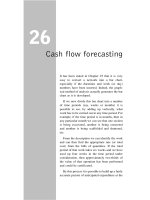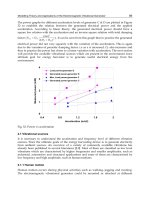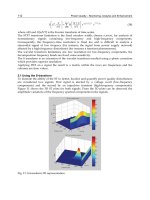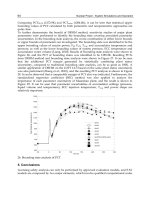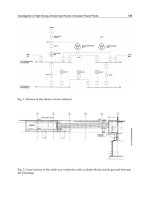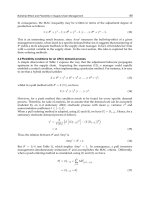Convert - Designing Websites to Increase Traffic and Conversion Part 6 doc
Bạn đang xem bản rút gọn của tài liệu. Xem và tải ngay bản đầy đủ của tài liệu tại đây (1.24 MB, 32 trang )
SELF-INTEREST
❘
135
For example, in Figure 7-7, we simply changed a few small elements to the page on
SkinnerInc.com that explains to potential sellers how they can sell through Skinner
to be more relevant to the seller, and instantly generated a 213% increase in downloads
of the evaluation form.
We changed the heading “Selling at Auction” to “Consigning to Auction is
Easy with Skinner.” Easy is a benefit, and the change of focus helps make the
process feel less remote.
We switched the two photos showing people’s backs to a single photo showing
an expert doing an evaluation, which feels more accessible and human.
We changed the lower heading from “Determining Auction Estimates and the
Appropriate Auction(s) for Your Property” to “How we Evaluate your Prop-
erty,” which is easier to understand.
Finally, we added an extra call to action button for “Get a Free Evaluation
Today.”
e combined eect of these small changes is to help the reader believe that it is easy
to go down the oered route.
FIGURE 7-7 A few simple changes to this page generated a massive 213% increase in conversions.
136
❘
CHAPTER 7: GET THEIR ATTENTION
Promise to Solve a Problem
What specic need does your oering propose to solve? Addressing that need directly
and oering the promise of a solution will speak to the prospect’s immediate concern
and trigger an emotional response.
If the benet is saving time, focus your whole appeal around that. If the need is to
save money, reduce stress, cure an ailment, avoid nes, or reduce risks, let your entire
message resonate clearly on the specic solution. e headline in Figure 7-8 tells the
visitor exactly what they can do on this site, and promises a specic result.
FIGURE 7-8 This home page headline makes a strong promise.
Benefits
Whatever the proposition, it is benets, not features, that hook visitors’ attention.
Benets fall into a few broad categories, including nancial gain, saving time, increas-
ing personal attractiveness, having fun, improving self-esteem, or being able to do
something you couldn’t achieve before.
It is critical to encourage visitors to take action today. is is easier when you give
them a benet that is quick and easy. e promise of getting what I want today is
more likely to get me to act now than some future benet.
Count the number of benets in my design for Surfulater.com in Figure 7-9. e page
opens with a strong you-oriented, immediate, and benet-laden headline: “Capture and
Find the Content You Need… instantly!” It follows with a sequence of minor headings
that address specic benets. “Save Anything Instantly,” “Retrieve Instantly,” “Edit &
Annotate Freely,” “Easy to Manage,” and “Share it Around” are all punchy benets that
could catch the attention of a prospect with a specic need in mind, leading to the call
to action, “Try it Now FREE,” to which the reasonable response should be, “Why not!”
SELF-INTEREST
❘
137
FIGURE 7-9 The Surfulater.com home page is loaded with benefits.
Benefits Appeal, Not Features
As I explained in Chapter 3, if your messages present only features, try ipping them
to benets. Go the extra mile to connect “what it does” to “what it does for you.”
Instead of listing benets, evoke them emotionally by helping your visitors visualize
how much easier their life will be. How will the benet impact the life of the reader?
138
❘
CHAPTER 7: GET THEIR ATTENTION
In Figure 7-10, visitors arrive at the site, a service that empowers individuals to
cut their own debt, with a single clear problem. It grabs attention immediately by
strongly asserting, “Yes you can!”
FIGURE 7-10 My design for a self-service debt management site answers the immediate personal
question with powerful and direct appeal.
More examples of ipping features to benets in headlines:
Same-day delivery (feature) becomes a benefit: “You can relax, knowing your
goods will arrive by 5pm.”
Server up-time (feature) becomes a benefit: “While you focus on your custom-
ers, we’ll be working to ensure your server is online 24/7.”
Long battery life (feature) becomes “Don’t worry if you have to jump on a last-
minute flight. Our laptop battery will take you from London to New York—
and back again.”
Great customer service (which is still a feature) becomes a personal benefit:
“Our award-winning on-board team will ensure you arrive relaxed and ready
for the day ahead.”
SELF-INTEREST
❘
139
Low prices (feature) become “With the $500 you’ll save by buying from us, you
could take the family away on a surprise vacation.”
Double-taped seams (feature) become “Whether you’re sailing offshore, trek-
king to base camp, or watching your child’s soccer match, our double-taped
seams ensure you stay warm and dry all day.”
Put Benefits Before Features
Notice how many items in the preceding list start with the benet, and then associate
the feature. It is the benet that grabs my attention by connecting emotionally with
my imagination. e feature should follow, creating a connection in my mind that the
benet is a consequence of the feature.
is simple connection helps create desire for the product on oer. If a web user is
comparing a few alternatives, she will assign more value to the one that oers her a
personal vision, that the benet will somehow enhance her life. Other products may
have the exact same features, but unless they are served to her as emotive benets,
they will not seem as compelling.
My home page design for an online bed store, as shown in Figure 7-11, leads with
a reassuring promise “You can sleep well.” e headline is a simple, direct benet,
which has two meanings, suggesting you will get a good night’s sleep on our comfort-
able beds, and also that you can rest easy because you can trust this vendor. ere are
no features in the headline, because the site has a wide range of products on oer. But
this high-level benet neatly applies to everything they sell.
AddAction is a low-cost but high-quality hosting provider, competing in a tough market.
In my preparatory interview, we explored what its existing clients love about the service.
FIGURE 7-11 Features never sold anything. This headline tells the customer the direct benefit to her,
before explaining how it may be achieved through one of their range of products.
140
❘
CHAPTER 7: GET THEIR ATTENTION
e company had recently received the following message from a happy customer:
“I submitted my ticket and 9 minutes later the issue was resolved. e best support
ever!” To me, that kind of passion is pure marketing gold, so I made it the focal point
of their new home page design, as shown in Figure 7-12.
FIGURE 7-12 Instead of competing on features in this packed hosting sector, this home page design
suggests important benefits (support) that connect more directly with the visitor.
SELF-INTEREST
❘
141
When It’s OK to Lead with Features
Sometimes it might be appropriate for a high-level page (such as a home page or
section page) to mention features. For example, if your keyword research suggests
that there is a signicant market looking for “exhibition experts,” you may lead with
that descriptive feature, provided you then go on to highlight your benets, as in
Figure 7-13.
FIGURE 7-13 Apply common sense. If you have a market that’s looking for features, by all means lead
with matching text on landing pages.
142
❘
CHAPTER 7: GET THEIR ATTENTION
Emotion
“People choose to buy based on emotion and then justify with logic” is one of the
fundamental laws of sales. e buying decision is usually already made emotionally
before logic comes into consideration, whether we are aware of it or not.
NOTE Rational thought and emotion occur in different parts of the brain. Emotional
responses actually happen faster than thought, so psychologists tell us that emotion
influences more of our choices than we imagine.
It is tempting to rely on facts, but information is not the key to prompting action.
Always look for emotional reasons that would compel a visitor to proceed. You can
give all the reasons you like for why something makes sense, but unless people con-
nect emotionally with the idea, they will not take action. Emotions, like love, fear,
attraction, and hope trigger action in ways that ideas alone cannot.
Features are in the realm of logic, but benets touch us personally and are in the
realm of emotion. We actually make buying choices based on emotions, then justify
our choice with reason. So it is benets that cause us to choose to act. Without ben-
ets to connect with we are unlikely to engage with a proposition. We may then also
need more solid information to reinforce our choice.
For example, instead of a generic proposition like “Flowers delivered,” see how the
following appeals qualify their target market, solve a problem, and oer the buyer
tangible benets:
Give Your Girlfriend the Perfect Valentine’s Gift—Under $30
How To Let Her Know “I Love You”
Funeral Wreaths Delivered In 24 Hours—Guaranteed
Last Minute Treat? These Gorgeous Summer Bouquets Delivered Nationwide
Next Day
Nothing Says “I’m Sorry” Like This Bouquet
A Splash of Color to Brighten Any Day
Demonstrating emotions like enthusiasm, passion, and commitment will evoke simi-
lar responses in your reader. Don’t shy away from letting your own emotion show in
your web site copy. Your customers are human, and they respond like humans, which
means they are dominated by their emotions.
EMOTION
❘
143
Figure 7-14 shows a large headline I created for the home page of a life coach. e
text “Live your life fully. Enjoy true success. Love every minute” works entirely in
the emotional realm. Who would not accept the oer of these benets? Because the
services and benets a life coach can oer can be so broad, this introduction sets out
to make a bold claim that inspires and creates enthusiasm at a high level. If prospects
connect with the emotions on display and are inspired, they will look further.
FIGURE 7-14 These promises speak directly to the emotional results on oer.
NOTE Simply adding quote marks to a headline often increases believability and con-
versions, because it suggests the statement is coming from a real person.
Figure 7-15 shows the content on our agency’s contact page before and aer a rewrite.
e page used to invite the visitor to get in touch, in a businesslike but aloof tone.
When we made it all about “you” (with seven mentions compared to two previously),
and added a photo of our London sales oce, conversions leaped by 94.7%.
Show the End Result
An easy shortcut to emotional connection is to show visitors a picture of the goal they
want to reach. We are motivated by the promise of an easier or more enjoyable life,
and it is this vision that keeps us moving forward. Showing the goal reached helps
keep the visitors’ eyes on the prize, which can soen the cost of whatever they have to
do to reach it.
144
❘
CHAPTER 7: GET THEIR ATTENTION
FIGURE 7-15 When we changed our agency’s contact page from dry facts to include a more personal
connection, nearly twice as many people responded.
For example, visitors to the BankLoans.com home page, shown in Figure 7-16, are
looking for the possibility of buying their home. My redesign connects with the visi-
tors’ end goal by showing the image of a person moving to a new home with a smile
on her face. is image connects with their personal desire and gives a strong signal
that they are in the right place to get what they want.
Fear
Fear can be a strong motivating emotion, but it is most eective when you can make
the pain of the fear immediately present, and oer instant relief.
“Are You Giving Away $$$ Every Month?”
“Hurry! Get Yours Before They’re All Gone!”
“Protect Your Family From Deadly EMF Radiation Today”
“Why Men Never Call Back—And What You Can Do About It”
EMOTION
❘
145
FIGURE 7-16 Showing the end result, moving home with a smile. Note how the emotion in the image
works in partnership with the main headline, which oers specific and immediate benefits.
As advertising on tobacco products has shown, the fear of a possible future negative
event is not a strong motivator. Human nature is more inclined to act on something
for immediate benet or relief than some potential risk. e exception to this is where
146
❘
CHAPTER 7: GET THEIR ATTENTION
the future problems would impact others, such as dependent family, so insurance
advertising uses the fear approach to good eect.
Reversing the Promise
It is hard to make a clever headline that generates good results. When you are work-
ing against the clock with limited attention currency, you generally do not want to
risk making people think too much. However, one approach that can work to get
people to read on is to tell them why the oer may not be relevant to them!
For example, when writing copy to promote a course in more eective life manage-
ment, I came up with the headline in Figure 7-17: “If You’re Getting Everything You
Want from Life, Don’t Read is!” Such appeals may stimulate a sense of exclusion,
which we naturally want to overcome.
FIGURE 7-17 Most people would admit they are not getting absolutely everything they want
from life, so this teasing reverse inclusion will exclude few prospects.
Credibility
Whatever emotions you stimulate in your appeal, you should sail as close as you can
to the wind, but keep your appeal credible enough to merit further investigation.
Ken McCarthy says that we all have two built-in lters, which the marketer must
avoid tripping. One is the “So what?” lter and the other is the “Nonsense!” lter.
Make sure that every statement you make will get through both of these lters.
A common way to trip the “So what?” lter is to ask a rhetorical question. Rhetorical
questions are questions that do not require an answer. Questions will only get people
to read if they require an answer. A frequent mistake I encounter is the “Why Should
You Use Us?” headline. is tends to be answered with, “I don’t know. It’s your web
site. You should be telling me.”
Two tips for keeping on the right side of people’s “Nonsense!” lter are to back up any
claims you make with facts and evidence, and to acknowledge possible doubts in the
reader’s mind (for example, “Like you, I was doubtful that a service that seemed so
cheap could deliver the quality I was used to, so I asked a bunch of questions…”).
DESIGNING FOR ATTENTION
❘
147
Designing for attention
You need to ensure your attention-grabbing content is the rst thing people notice. If
you draw someone’s attention to something, be sure you want them to read it.
When thinking about what your web page needs to communicate, you should now have
a good idea of which values or concepts should be prominent. A few basic principles for
graphic design will help you to get the attention you need, cleanly and eciently:
Getability
Noticeability
Navigation
Imagery
Look and feel
Getability
If visitors can nd the signs to answer the golden question (“Am I in the right place?”)
in the rst few seconds, they are likely to decide that moving forward oers better
odds than moving backward, which means you have their attention. If they do not
nd those clues, retreating may seem the better option, and your attention-seeking
has failed.
I call the quality of how easy it is to “get” a page’s purpose getability.
e page’s rst job is to say “Yes—you are probably in the right place.” When a page
has good getability, visitors will say “I get it, and I know what to do next,” without
really needing to think. e signs they need will jump straight out. is means those
key clues need to be the rst things they notice.
What visitors need to see to know they’re in the right place depends on the context.
Consider where they are on the Awareness Ladder, what they are trying to achieve,
and how they may have arrived at the page.
In just a thin slice of time, your site has to come across as the right kind of site, with
the right subject matter and tone. (Of course “right” might mean cheap or expensive,
professional or amateur, depending on the values you want to communicate.)
All you need to do for high getability is to present plain, obvious communication.
Any cryptic, conicting, or misleading messages will cause mental friction, reduce
getability, and damage your conversion rates.
148
❘
CHAPTER 7: GET THEIR ATTENTION
One of the most eective ways to increase getability is to strip away things that are
not required. Identify the features that can help answer “Am I in the right place?” and
try removing anything that does not. e result has to be more attention available for
the content that matters, which can only increase your chance of getting someone’s
attention. e pure simplicity of the Google search page, with one primary function
that dominates attention, could be one of the main factors in its success.
You can simplify any aspect of content or design, including layout. Figure 7-18 shows
a test we ran on a previous version of the “Save the Pixel” sales page. Simply removing
the le-hand column, with its navigation options, newsletter sign-up box, and extra
info, increased sales by 20.5%. Because there are fewer things for visitors to look at,
they are more likely to engage with the core message.
FIGURE 7-18 Removing the side column on the old “Save the Pixel” sales page delivered a 20.5%
increase in sales by focusing on the proposition.
Figure 7-19 shows a view from Gurushot.com, a web-based application we designed
and built, which shows visitors wisdom quotes in response to their queries. e site’s
design excludes any elements that are unnecessary for delivering the desired experi-
ence, allowing users to focus directly on the content.
Noticeability
Getability depends on another factor, which is the relative noticeability of the various
elements presented. Every element has its own level of noticeability—how strongly it
pulls the eye and calls attention to itself.
DESIGNING FOR ATTENTION
❘
149
FIGURE 7-19 Gurushot.com has a minimalist design that focuses attention on the relevant content.
I identify eight design factors that can aect noticeability:
Size
Contrast
Boldness
Color
Position
Space
3-D Effects
Movement
e important thing to remember is that these factors all work together in the same
space. You can use any combination of them to change the relative noticeability of
visual elements.
150
❘
CHAPTER 7: GET THEIR ATTENTION
e trick is to balance them sensitively in order to create the right overall eect,
which is that the eye is drawn naturally to the primary features, and can take in each
one in turn, without being distracted by competing minor elements.
How to nd the right balance is outside the scope of this book. It requires sensitiv-
ity and experience. e fundamental technique is to look at the page as though you
are seeing it for the rst time, and to spot where your eye is drawn. If it is the wrong
place, consider what is drawing your attention, and try to x the balance.
SIZE
e bigger an element is, the more important it seems to be. Increasing the relative
sizes of visual elements is an easy way to adjust their relative noticeability.
Don’t treat your web pages like works of art. ey do not have to be perfectly bal-
anced. e longer you look at an entire page design, the farther you will dri from
the way it is actually used—which is scanned quickly for clues. Try to make a page
entirely consistent and balanced and you will end up with something that lacks the
critical edge it needs to grab attention.
Many pages can aord to increase the size of the initial headline and other primary
messaging. When you remove unnecessary visual clutter, you have more space avail-
able, so you can enlarge the primary signals, as shown in my design for EventRight,
shown in Figure 7-20. e eye can only settle on elements that have content value: the
identity, navigation, copy, and content imagery.
CONTRAST
Tonal contrast is a very important factor. e sharper an element’s contrast (the bal-
ance between light and dark) with its surroundings, the more it stands out. I will oer
some important tips on using contrast in your page designs.
Try squinting at the page through almost-closed eyes, so that the screen blurs. Can you
spot some areas of contrasting tones (usually dark-on-white)? If not, you may not have
anything that has enough contrast to draw the eye. Many designers have a natural ten-
dency to reduce contrast of a design the longer they stare at it. Try to add some content
that is both important and higher-contrasting (which can be large text, or imagery).
Figure 7-21 shows the EventRight design with a blur eect applied, which reveals
strong contrast around the logo (top-le) the main call to action (top-right), the dark
navigation strip, the photograph at the bottom right, and the black-on-white heading
at the top of the content area. e heading in the header strip does not show up so well,
because it is white against a mid-tone background, so it may be more eective either
to use black text or to darken the background.
DESIGNING FOR ATTENTION
❘
151
FIGURE 7-20 Using fewer visual elements lets you make the most important ones larger and more
noticeable.
FIGURE 7-21 Use the squint test to check how many dierent areas of strongly contrasting tones your
page has.
152
❘
CHAPTER 7: GET THEIR ATTENTION
If you see more than about ten areas of contrast, you could end up with a page that is
drawing the eye in too many dierent directions, which means that it will not be able
to focus on any one area.
Edges of strongly contrasting tones draw the eye. If you nd it’s hard to read a web
page, check the contrast between the main content area and the page background. If
there is high contrast, this will constantly pull your attention away from the content.
I prefer to use white for the main content area and light tones for backgrounds, creat-
ing a low-contrast boundary.
BOLDNESS
Boldness is a feature that emphasizes tonal contrast. Stronger, heavier lines create
clearer tonal boundaries, which draw the eye. Boldness is most oen associated with
text. Use either large type size, and/or a bolder typeface for your main headings.
Lightweight text will be less noticeable. You may also apply bold weight to specic
words in content, if you want them to jump out.
COLOR
Color works in a similar way to contrast, in that it can create distinction between ele-
ments. Pages should have a basic color scheme (which may be subtle and consistent,
or brash and cheap, depending on the brand).
e two basic principles are:
Use the same colors to tie together areas.
Use contrasting colors (usually from the opposite side of the color wheel) to
draw attention to specific features.
For example, if your main page hue is cold and blue, you may use orange or red as a
highlight (or “spot”) color, which would stand out. If the design is based on a warm
color scheme, you might use blue or green for contrast.
I recommend keeping the background colors of pages so. Also, if you use too many
dierent colors on the same page, it becomes dicult to make anything stand out,
and the reader may feel overwhelmed.
POSITION
Clearly, your main message should be near the top of your page. Specically, it should
be at the top of your content area. is assumes that the regular page “furniture”
(including logo and permanent navigation) are easily distinguishable, which means
DESIGNING FOR ATTENTION
❘
153
the visitor can group them and ignore them to move straight to the main heading and
imagery.
Do not put so much at the top of the page that the primary content risks ending up
“below the fold” (that is, the visitor will need to scroll to see it)!
Follow conventions when positioning elements on screen. Eye tracking research
shows that some areas of the page, such as the top-right corner, tend to be seen as
lower priority than others. Other areas, like the top-le of the main content area, are
more oen focused on.
When you rst look at a page, where is your eye drawn? It is likely to be an element
that combines several of the noticeability factors.
Use those noticeability factors to draw attention to the page’s unique main content,
starting with the headline. If attention is drawn to a feature that is not unique to the
page, or to content that does not help get visitors’ attention, there is a great opportu-
nity to improve click through.
SPACE
Putting space around any element makes it more noticeable. It is easier to recognize
the shape (silhouette) of an object if it is not crowded by other elements.
I advise removing boxes and lines wherever possible, because this creates more space
on your page, meaning that everything can be slightly easier to read, and allows you
to use more extra space around your most important elements.
I also like to use increased line height in body text, and also to add extra vertical
space between columns, as I nd this increases readability.
Figure 7-22 shows a section from an e-commerce page I redesigned recently. Note
how each element has enough white space around it to make it easy to read. Don’t be
tempted to cram content close together—unless you do not want it to be read!
3-D EFFECTS
Some graphical eects create the illusion of 3-D space. ese include gradients, drop
shadows, and reections. When you give an element space or shape in this way, it lit-
erally stands out from the page.
We are naturally drawn to things that are shiny or seem to have shape. ere are a
few general rules to using 3-D eects. Because, most of the time, they use light shad-
ing to create the eect, it is advisable to keep the source of the light consistent. If light
seems to come from many directions at once, it can break the illusion.
154
❘
CHAPTER 7: GET THEIR ATTENTION
I would also advise against using too many eects. You do not want to draw attention
to too many elements, so reserve 3-D eects for particular content. Use it minimally
on elements that are present on every page, because you do not want to make these
too noticeable.
FIGURE 7-22 Although this page section includes a lot of content, I ensured
all the important information has some space around it for good readability.
Figure 7-23 shows my design for Synctus.com, which makes a clever device that syn-
chronizes les on special hard drives between multiple locations via the Internet. e
design creates the illusion of a large shape that seems to be on a at virtual plane,
creating a 3-D suggestion of a diagram showing how data moves between multiple
back-up storage devices.
DESIGNING FOR ATTENTION
❘
155
Note how the headline “Synch les between oces… Quickly, Securely, Easily” dis-
tinguishes the market for the product. e only people who would ever need this
solution will be those with responsibility for IT for organizations that have multiple
oces. So the headline immediately qualies that market in, disqualies the rest, and
also includes three dierentiating features.
FIGURE 7-23 The Synctus site uses the illusion of 3-D space to draw attention to the product and main
content.
MOVEMENT
ings that move grab our attention. It is an unavoidable biological fact. We are
tuned to spot movement, which could be prey or a threat. Some of the most annoying
online ads use this fact and apply animation to catch your eye.
156
❘
CHAPTER 7: GET THEIR ATTENTION
ere is a more subtle type of dynamism that you can use, which is the suggestion of
movement. Diagonal lines and shapes are more dynamic than square angles, so use
them to draw the eye (but be careful not to lead the eye o the page).
TESTING AND FIXING NOTICEABILITY
Figure 7-24 shows the results of a fascinating test. I initially redesigned the header
strip of towelsdirect.co.uk to focus more on benets to the customer. (To run the test,
I used Google Website Optimizer, which is covered fully in Chapter 11.)
Here are the changes I tested:
I increased the noticeability of the logo, phone number, and the three key features.
I crafted a new strap line (the title that goes with the logo to explain the offering).
I added a badge graphic claiming “#1 Choice.”
e result was a signicant drop in conversion rate of 45.4%!
FIGURE 7-24 Three headers on towelsdirect.co.uk, showing a huge turnaround in conversion rates from
a few seemingly minor changes.
I had to ask what might have caused such a negative impact. I wondered whether the
badge and the other features were drawing attention away from the content, so I tried
the third strip, where I removed the badge and reduced the size and contrast of the
text. is produced a 46.5% increase in conversion rate over the original strip!
What could explain the switch?
Perhaps the “#1 Choice” badge lacked credibility.
Maybe the heading was too cluttered and visually distracting.
DESIGNING FOR ATTENTION
❘
157
Or, it could be that the most noticeable items were not what people needed to
see to get their attention.
e lesson to draw from this example is that all the content and design factors inter-
act in complex and subtle ways. We should use all the skills and knowledge at our
disposal to make our very best guess designs, but we must always test.
WARNING Increasing the noticeability of an unhelpful element can have a negative
impact on success. If you have made something more noticeable or readable and con-
version drops, look more closely at what draws attention. How could it be unhelpful?
Navigation
Your site’s permanent navigation does three jobs:
Tells you where you are
Tells you where else you can go
Gives you a means to get there
All three factors are important for getability. A new site’s navigation structure works
like signage in a store, giving visitors a good idea both of where they are and what is
available, which gives them clues as to what kind of site they’re on. So ensure your
top navigation is clear, descriptive, and useful. Even if visitors do not see the next step
forward on the page, hopefully your clear navigation will oer them somewhere else
to look without leaving the site.
Notice how the simple navigation in Figure 7-25 makes it totally clear where you are
now, including an arrow that points to the content, as well as where you can go next.
A strong headline communicates the proposition, and the simple layout leads the eye
through the message to two clear next steps.
Imagery
Although graphics do not generally impact conversion as much as text content, the
rst imagery you notice when arriving on a new page is important for getability.
Ensure that the rst images people notice directly communicate the subject matter of
the page.
158
❘
CHAPTER 7: GET THEIR ATTENTION
FIGURE 7-25 My design for the home page of Win.tv features simple navigation that makes it obvious
where you are and where you can go.
For example, if your site has a photo of a car on it, what does that say? You could sell
cars, insurance, driving lessons, valet services, or car polish! If you sell insurance,
DESIGNING FOR ATTENTION
❘
159
make sure the imagery supports your intended message. If you sell driving lessons,
clearly show driving lessons, and people will get they’re in the right place.
NOTE Tests run by the Ogilvy agency several decades ago proved that when people
are presented with an advertisement that features an image of some item, they are
likely to assume the item has something to do with the ad. So if you sell computer soft-
ware solutions, don’t show a bridge. If you sell loans, don’t show an empty park bench
(both real examples from sites I have redesigned).
One thing you do know about everyone who comes to your site is that they are peo-
ple. People are most interested in two things: themselves and other people. As social
animals, we get a lot of information from others’ faces, so our brains are tuned to pay
attention to faces.
Showing a human face is an easy way to increase the attention-pulling power of a
page. If that face is smiling and looking at the camera, it gets even more attention.
Figure 7-26 shows two versions of the main product shot from a client’s sales page
(bibletimeline.net). e original picture had shown the chart’s format, but did not
give an idea of either the size of the product or the details it provides.
For our initial test, we added a close-up of a small area of detail, showing more of the
information that is available on the chart. We also added width and height measure-
ments showing its scale. We expected an increase in conversion rate, based on the
principle that people like detail. However, there was no improvement at all.
FIGURE 7-26 Adding a smiling person boosted conversions by 38%.

